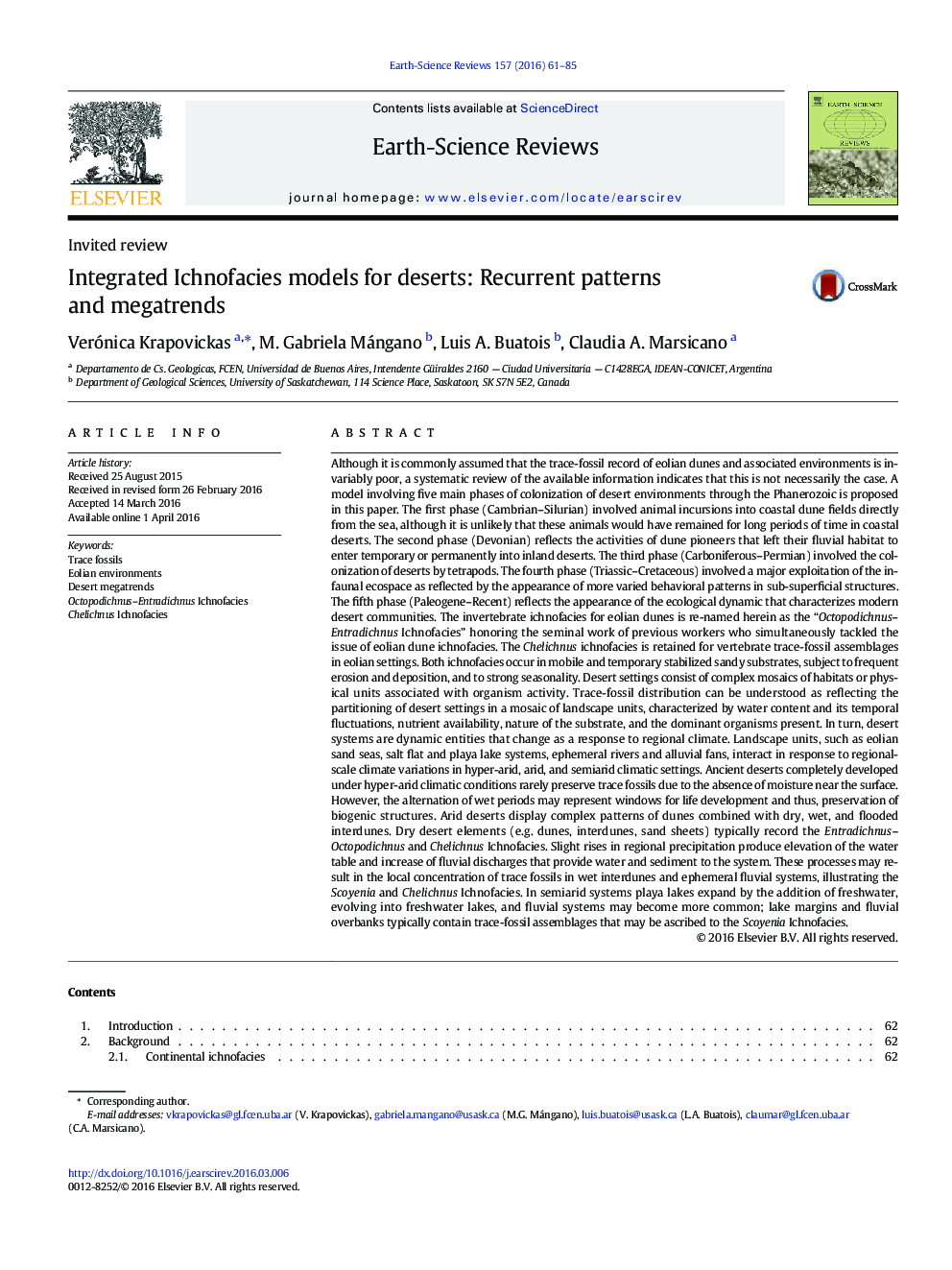| کد مقاله | کد نشریه | سال انتشار | مقاله انگلیسی | نسخه تمام متن |
|---|---|---|---|---|
| 4725619 | 1639945 | 2016 | 25 صفحه PDF | دانلود رایگان |

Although it is commonly assumed that the trace-fossil record of eolian dunes and associated environments is invariably poor, a systematic review of the available information indicates that this is not necessarily the case. A model involving five main phases of colonization of desert environments through the Phanerozoic is proposed in this paper. The first phase (Cambrian–Silurian) involved animal incursions into coastal dune fields directly from the sea, although it is unlikely that these animals would have remained for long periods of time in coastal deserts. The second phase (Devonian) reflects the activities of dune pioneers that left their fluvial habitat to enter temporary or permanently into inland deserts. The third phase (Carboniferous–Permian) involved the colonization of deserts by tetrapods. The fourth phase (Triassic–Cretaceous) involved a major exploitation of the infaunal ecospace as reflected by the appearance of more varied behavioral patterns in sub-superficial structures. The fifth phase (Paleogene–Recent) reflects the appearance of the ecological dynamic that characterizes modern desert communities. The invertebrate ichnofacies for eolian dunes is re-named herein as the “Octopodichnus–Entradichnus Ichnofacies” honoring the seminal work of previous workers who simultaneously tackled the issue of eolian dune ichnofacies. The Chelichnus ichnofacies is retained for vertebrate trace-fossil assemblages in eolian settings. Both ichnofacies occur in mobile and temporary stabilized sandy substrates, subject to frequent erosion and deposition, and to strong seasonality. Desert settings consist of complex mosaics of habitats or physical units associated with organism activity. Trace-fossil distribution can be understood as reflecting the partitioning of desert settings in a mosaic of landscape units, characterized by water content and its temporal fluctuations, nutrient availability, nature of the substrate, and the dominant organisms present. In turn, desert systems are dynamic entities that change as a response to regional climate. Landscape units, such as eolian sand seas, salt flat and playa lake systems, ephemeral rivers and alluvial fans, interact in response to regional-scale climate variations in hyper-arid, arid, and semiarid climatic settings. Ancient deserts completely developed under hyper-arid climatic conditions rarely preserve trace fossils due to the absence of moisture near the surface. However, the alternation of wet periods may represent windows for life development and thus, preservation of biogenic structures. Arid deserts display complex patterns of dunes combined with dry, wet, and flooded interdunes. Dry desert elements (e.g. dunes, interdunes, sand sheets) typically record the Entradichnus–Octopodichnus and Chelichnus Ichnofacies. Slight rises in regional precipitation produce elevation of the water table and increase of fluvial discharges that provide water and sediment to the system. These processes may result in the local concentration of trace fossils in wet interdunes and ephemeral fluvial systems, illustrating the Scoyenia and Chelichnus Ichnofacies. In semiarid systems playa lakes expand by the addition of freshwater, evolving into freshwater lakes, and fluvial systems may become more common; lake margins and fluvial overbanks typically contain trace-fossil assemblages that may be ascribed to the Scoyenia Ichnofacies.
Journal: Earth-Science Reviews - Volume 157, June 2016, Pages 61–85